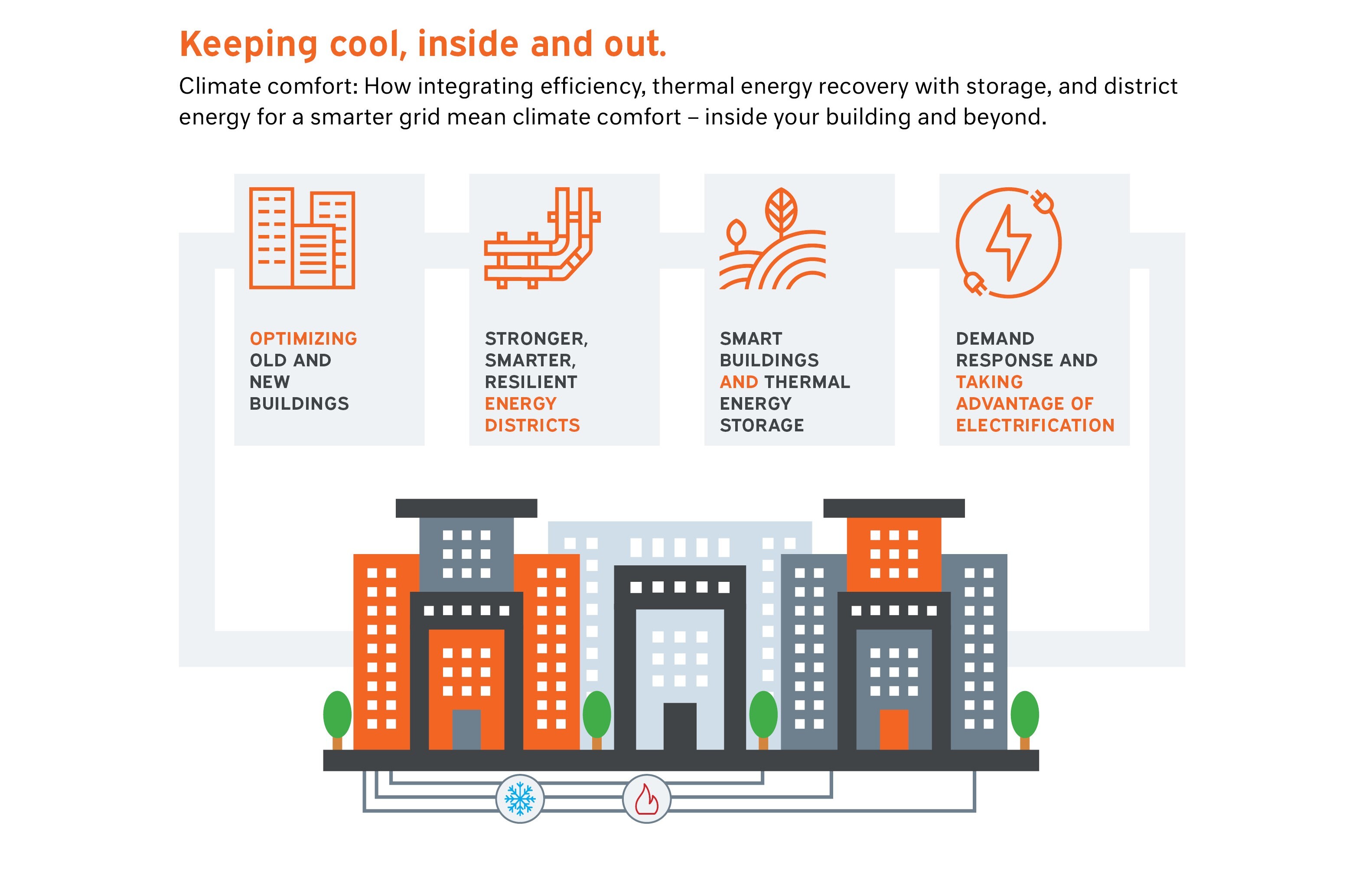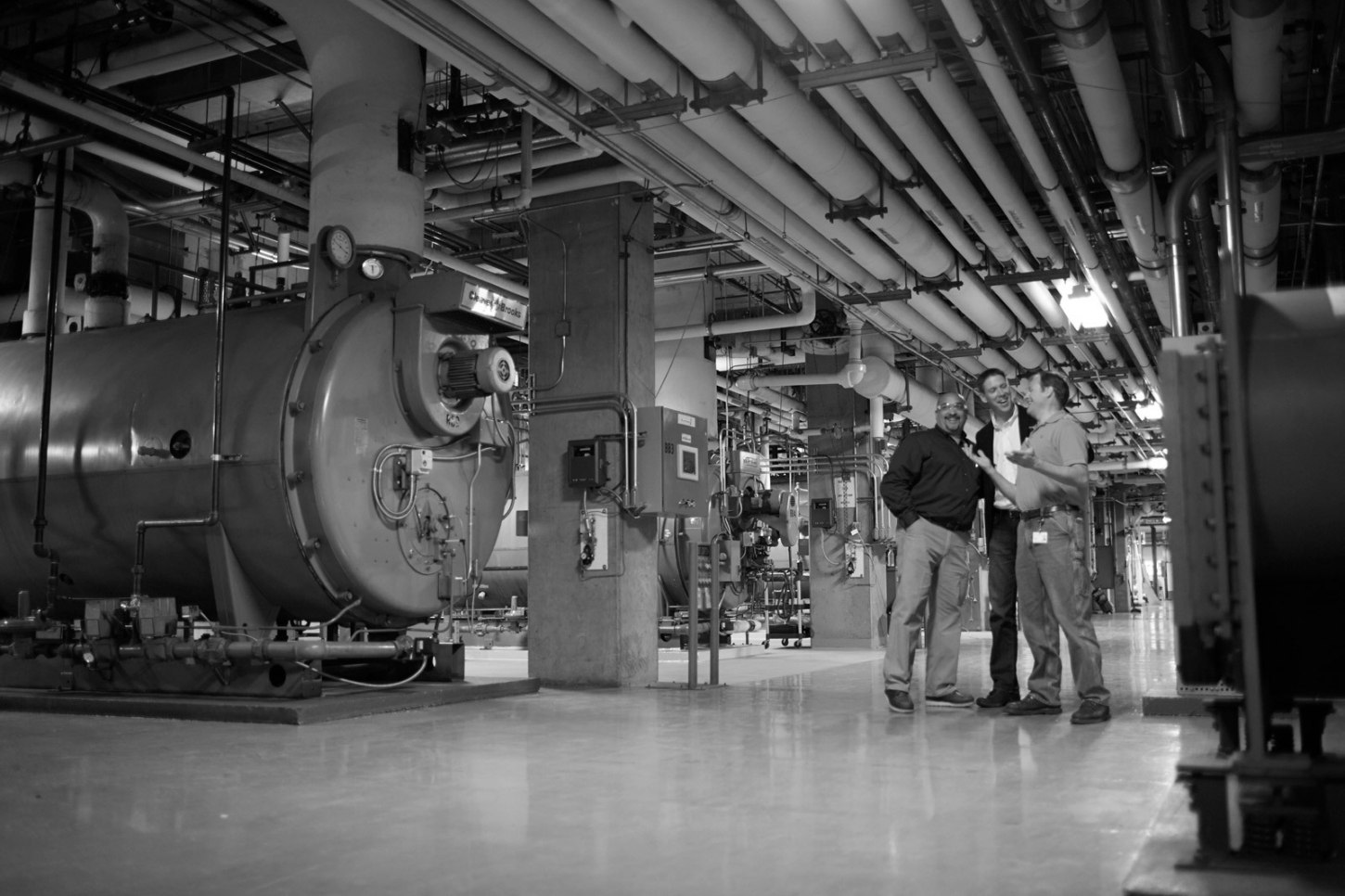*This article was originally published on the Northwest Energy Efficiency Council (NEEC) blog series: Challenges & Opportunities of the Clean Energy Future. Click HERE to view the feature.
Climate comfort: How integrating efficiency, thermal energy recovery with storage, and district energy for a smarter grid mean climate comfort – inside your building and beyond.
Northwesterners are spending more months fleeing to indoor air-conditioned spaces. But outdoor ‘heat domes’ and wildfires are only signs of more to come as global climate instability progresses. As we’re seeking out indoor climate comfort, it’s smarter than ever to build toward global climate stability too.
The smart path to energy and carbon savings in the built environment integrates infrastructure renewal for existing buildings, best carbon and efficiency standards in new buildings, connects them all with district energy, and offers to futureproof with thermal energy’s reliable storage of clean electricity. Altogether, the built environment can affordably offer comfort, carbon responsibility, and resiliency by anchoring the smart grid of the future – our sector’s essential climate solution. Let’s get to work.

1.Efficiency first, both in old buildings and new.
Washington’s buildings account for 20% of our state’s entire carbon footprint, and more than half of those building emissions come from thermal energy demand. Comprehensive analysis for the 2021 State Energy Strategy found that energy efficiency and electrification are the lowest-cost paths to meet the state’s greenhouse gas emissions limits for buildings. Decarbonizing our region’s buildings sector requires that we:
- Maximize energy efficiency and minimize embodied carbon,
- Maximize electrification: emissions from fossil gas in buildings must decline 14% by 2030 and continue to decline at an increasing rate through 2050, to save grid space for further electrifying buildings and transportation, all to
- Optimize buildings as grid resources.
These are tall challenges for new buildings to meet, but even tougher for our region’s vast inventory of existing buildings. Washington State has hundreds of millions of existing square footage needing renewal. Years of deferred maintenance mean major inefficiencies are straining operating budgets. Such equipment wheezing past life expectancy could fail abruptly, leaving facility operators scrambling for emergency repairs of critical systems. Deferred maintenance at Washington’s public universities alone reaches into the tens of billions of dollars, as reported at WSU, UW, and others. How can Washington buildings affordably recommission for comfort, carbon, and resiliency?
Instead of scraping and rebuilding, owners should minimize embodied carbon by renewing existing buildings and optimizing efficiency wherever possible. Indeed, commercial buildings are already planning how needed upgrades can meet compliance with the City of Seattle’s robust new commercial energy code, and strategizing new updates entirely to comply with the statewide Clean Buildings Standard (buildings 50,000+ square feet).
Beyond mere code, compliance lays an even greater efficiency opportunity: reusing clean electricity via thermal energy recovery and storage. In the summertime, heat pumps powered by clean electricity can cool buildings, extracting the heat for use in domestic hot water right away or storing it overnight to rewarm the building the morning. In the winter, this process is reversed to extract heat from exterior water, geo-exchange, waste, or exhaust air from nearby buildings to use this clean heat to rewarm the building. Thermal energy surrounds our buildings: it is more efficient to simply keep moving that energy with a heat pump than to generate new thermal energy from scratch.
Reclaimed thermal resources can be used immediately as cool or warm air or water or stored in insulated tanks for later needs on-demand. Such “thermal battery” systems rank top-notch with other methods of energy storage, at 85-95% efficiency compared to pumped hydropower’s 70-80% efficiency. Thermal energy recovery and storage in the built environment is a unique energy efficiency measure, cost-effectively storing clean electricity to be reclaimed again and again. Heat is cool.
Most new buildings now have well-tuned internal thermal recovery systems; most old ones do not. Deep efficiency and resiliency measures sound like a tall order for old buildings, but we can do this. Long before mandates required it, UMC optimized and electrified the headquarters of the Washington State Dept. of Labor & Industries and the Alaska St. Building (an office of the WA State Services for the Blind). Now with a simple addition of onsite clean energy generation, these and dozens of more large buildings are ready to go fully zero-carbon. A well-planned, phased approach for long-term lifecycle benefits is key to affordable infrastructure renewal.
We can do this hard work, and it’s worth it. Climate comfort is valuable inside individual buildings: occupant productivity contributes to the return on investment for renewing a building’s mechanical systems. And deep decarbonization helps delay the instabilities of a changing climate: that’s a ‘climate comfort’ for all of us. Renewing existing buildings’ infrastructure offers comfort, carbon, and resiliency.
2. Energy districts: Stronger, smarter, more resilient together.
Teamwork brings even greater efficiencies. Buildings competitively served by resilient, sustainable, self-sustaining district energy systems benefit from sharing heating and cooling, space savings, and resource efficiencies afforded by scale. District energy connecting refreshed old buildings and new green buildings alike helps each structure achieve its own maximum performance. The 2021 State Energy Strategy highlighted the zero-carbon opportunity for campus district energy. As energy-sharing networks grow, the members buildings’ benefits increase and emissions overall decrease.
UMC has created solutions for some of our region’s most challenging district energy and thermal storage systems. These include Amazon’s famous Spheres, the US Army Corps of Engineers, Washington State universities and agencies, sewer heat recovery for new panelized high-rises, regional medical and research centers, and more.
3. Anchoring the smart grid: Efficient smart buildings and thermal energy storage.
Renewed existing buildings and fresh new ones – all connected by thermal district infrastructure, responsive energy controls, and thermally stored clean energy– will anchor the smart grid of the future.
District cooling and heating systems with thermal energy storage empower buildings to integrate into the larger electric grid, offering demand-response, peak-shifting, and accelerating transportation electrification. That means affordable climate comfort, carbon, and resiliency – for the individual buildings involved, for their linked energy districts, and the broader community.
District energy technologies are proven. Now new business models are evolving to take advantage of the considerable value of district energy systems. To accelerate, clearer regulatory certainty will invite private investment and public participation in energy district and thermal storage infrastructure in Washington State. It’s good to see early policy signals in the energy codes and Clean Buildings Standard already mentioned, plus the 2019 Clean Energy Transformation Act for utilities, Executive Orders 18-01 and 20-01 from Governor Inslee to ramp efficiency in state-owned buildings, the building's section of the 2021 Climate Commitment Act’s cap-and-invest program, and more.
Electric and gas utilities are also offering regulatory certainty with more rate designs that encourage buildings to function grid-interactively. UMC’s own local Snohomish Public Utility District has newly debuted “FlexEnergy Pilot Programs” to offer residential customers opportunities to “earn bill credits and save on your energy bill by using energy at off-peak times or leveraging smart thermostats or EV chargers.” This ‘critical peak price’ is a step closer to a smarter grid’s time-of-use rates, which can also put larger buildings to work unlocking grid-scale efficiencies. With thermal storage for clean energy, districted buildings can be ready to serve the smart grid on demand.
The Northwest is well-positioned to join other regions leading on district energy and storage. North American examples already include airports, education and healthcare campuses, downtown areas, government complexes, military bases, industrial sites, and more. Without having to be the earliest adopter, our region can still lead in scaling up the smart grid with district energy storage for comfort, carbon, and resiliency.
The built environment can offer comfort, carbon responsibility, and resiliency.
Finally, this all sounds like a whole lot of work, right? Yes – jobs! District heat and thermal energy storage call on a wide range of expertise. At the outset, district energy developers – like UMC’s close ally, dJoule – link the partners to plan and finance enterprises that execute district energy projects. Energy modelers find efficiencies in existing buildings and new buildings’ blueprints, industrial teams manufacture precision piping, controls experts ensure infrastructure runs at peak performance, and Plumbers and Pipefitters, Sheet Metal experts, Electricians, and many more trades tackle the challenge of putting it all together.
Building infrastructure is boots-on-the-ground work that can’t be outsourced. Renewing existing buildings, adding durable new ones, linked by district energy with thermal storage, and integrated them into the efficient smart grid of the future will demand skilled building professionals right here in the Northwest.
Good green jobs for technically minded people? How very Northwest. Let’s get to work.
Questions or Comments?
For media inquiries or related questions, please contact info@umci.com
